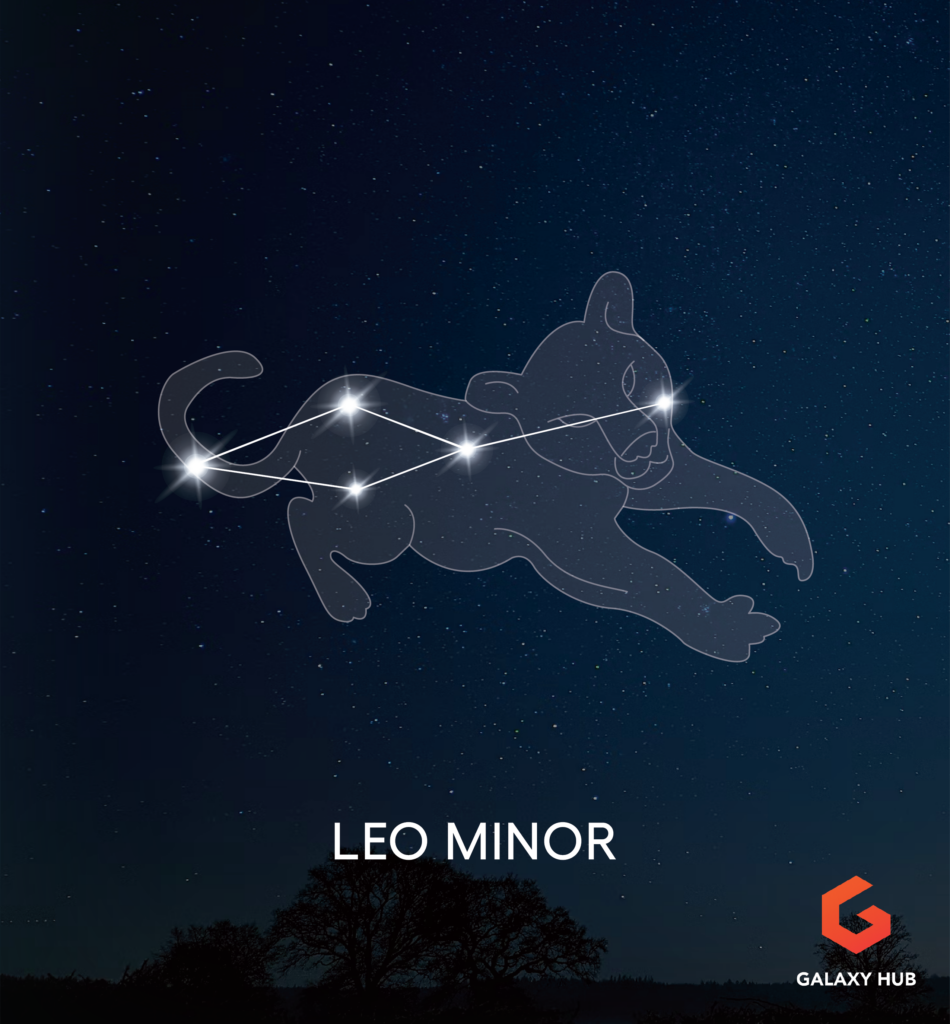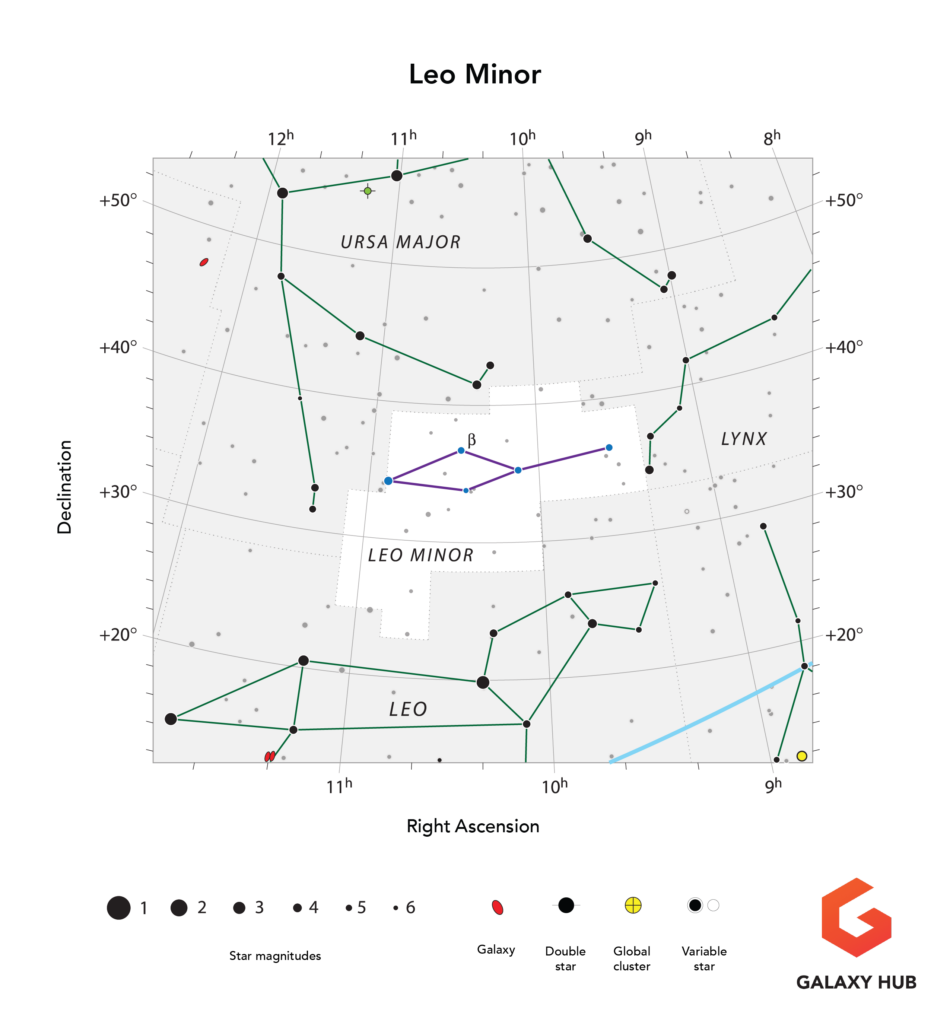
Leo Minor is a small, faint constellation in the northern hemisphere, most visible to observers in spring and early summer. The constellation contains mainly dimmer stars, but with the right equipment plenty of interesting deep-sky objects can be seen in the region.
Stargazers in the northern hemisphere will see the constellation nearly overhead, while southern hemisphere observers will need to look closer to the horizon. The constellation is best seen from suburban to rural skies, and will not be visible from the core of a larger city.
Leo Minor Key Data
Name
| Latin | English | Pronunciation | Genitive | Abbreviation |
| Leo Minor | The Smaller Lion | Lee-Oh Mahy-Ner | Leonis Minoris | LMi |
Location
| Hemisphere | Best Seen | R.A. | Declination |
| Northern | Early April to Late June | 10h | +30° |
Features
| Area | Size Rank | # of Messier Objects | # of Stars Brighter than Mag 4 | Brightest Star |
| 232 sq. Deg. | 64th | 0 | 1 | 46 Leonis Minoris Mag 3.8 |

Top Leo Minor Facts
- The constellation is best seen from Early April to Late June
- Leo Minor ranks 64rd in size among all 88 constellations
- Leo Minor was only named in 1687, and is not a classical constellation.
- Leo Minor represents a female lion companion to Leo Major.
- Leo Minor contains no bright stars.
- The Leonis Minorids meteor shower originates in Leo Minor.
Leo Minor in History
Unlike all of its neighboring constellations, Leo Minor is not a classical constellation and has no mythology associated with it.
When Ptolemy was first navigating the night sky, he considered the region between Ursa Major and Leo Major (at the time, simply Leo) to be undefined. Stars inside the region were simply considered amorphōtoi, belonging to no constellation line but still within Leo.
The region was named in 1687, when Johannes Hevelius first depicted the region between Ursa Major and Leo as a smaller lion, Leo Minor. According to Christian Ludwig Ideler, a historian in the 1800’s, the stars in Leo Minor were recorded on an Islamic globe in the 1300’s as Al Thibā’ wa-Aulāduhā, meaning ‘Gazelle with her Young’.
In Chinese astronomy, the four brightest stars of Leo Minor are known as The Court Eunuch.

When and How to See Leo Minor
Leo Minor can be spotted in the Northern Hemisphere by looking up during the spring and early summer. The constellation lies midway between Ursa Major, an easily spotted constellation, and Leo Major, a zodiac constellation. Southern Hemisphere observers will be able to see the constellation close to the northern horizon.
To see Leo Minor, first find Ursa Major and Leo Major. Imagine a line connecting the two constellations together, and look at the middle of the line. This is where Leo Minor sits; the four stars forming a zig-zag across that line are Leo Minor.

Leo Minor’s Notable Stars
| Bayer/Flamsteed Designation | Name (s) | Mag | R.A. | Dec. | Distance (LY) | Notes |
| 46 Leonis Minoris* | Praecipua | 3.8 | 10h 53m 18s | +34° 12′ 56″ | 98 | Leo Minor’s brightest star |
| Beta / 31 | N/A | 4.2 | 10h 27m 53s | +36° 42’ 26” | 146 | 2nd brightest star |
*One star in Leo Minor was given a Bayer designation.
46 Leonis Minoris
While 46 Leonis Minoris is the brightest star in Leo Minor, it does not have a Bayer designation. It is uncertain why this is the case, as the star is bright enough to make the cutoff for Bayer’s catalog. Sometimes, the star is referred to as ‘o LMi’, given an English o instead of a Greek omicron.
The IAU recognized name for 46 Leonis Minors is Praecipua, ‘The Chief’. In Chinese astronomy, 46 Leonis Minoris is known as ‘the Fourth (Star) of the Eunuch’.
46 Leonis Minoris is a potential variable star, and is a red clump giant star.
Beta Leonis Minoris
Beta Leonis Minoris is the only member of Leo Minor with a Bayer designation, despite being the second brightest star. The star is a binary star system with a period of 39 years; the primary star is a red clump giant star while the secondary star is a subgiant.
Leo Minor’s Deep Sky Objects
| Object | Name(s) | Type | Mag | R.A. | Dec. | Distance (LY) | Min. Equipment |
| NGC 3432 | N/A | Edge-On Galaxy | 11.6 | 10h 52m 31s | +26° 37’ 08” | 42,000,000 | Small Astrophotography Setup |
| NGC 3003 | N/A | Edge-On Barred Spiral Galaxy | 11.7 | 09h 48m 35s | +33° 25’ 17” | 63,000,000 | Small Astrophotography Setup |
| NGC 3344 | N/A | Barred Spiral Galaxy | 10.5 | 10h 43m 31s | +24° 55’ 20” | 22,500,000 | Small Astrophotography Setup |
| NGC 3504 | N/A | Barred Spiral Galaxy | 11.7 | 11h 03m 11s | +27° 58’ 21” | 26,000,000 | Small Astrophotography Setup |
| NGC 3486 | N/A | Intermediate Barred Spiral Galaxy | 10.5 | 11h 00m 23s | +28° 58’ 29” | 27,000,000 | Small Astrophotography Setup |
| NGC 2859 | N/A | Barred Lenticular Galaxy | 11.8 | 09h 24m 18s | +34° 30’ 48” | 82,000,000 | Small Astrophotography Setup |
| Arp 107 | N/A | Interacting Galaxies | 14.6 | 10h 52m 14s | +30° 03’ 28” | 450,000,000 | Astrophotography Setup |
| Hanny’s Voorwerp | IC 2497 | Quasar Ionization Echo | 19 | 09h 41m 04s | +34° 43’ 34” | 650,000,000 | Astrophotography Setup |
Galaxies
Leo Minor is a galaxy target gallery, filled with distant and unique galaxies. To see any of the deep sky objects in Leo Minor, you will need an astrophotography setup or a massive telescope. This can be prohibitive to all but the most well-invested astronomers, but the results are worth it! Many of the galaxies in Leo Minor are unique and interesting to study.
There are six NGC objects in Leo Minor, making up the majority of the interesting deep sky objects.
NGC 3432 (Edge-On Galaxy)
NGC 3432 is an edge-on galaxy about 42 million light years away, presenting an almost perfectly flat line in the sky. The galaxy has an interacting dwarf galaxy initiating star formation and tidal filaments, and is being researched to better understand gravitational effects on galaxies.
NGC 3003 (Edge-On Spiral Galaxy)
NGC 3003 is another edge-on spiral galaxy about 63 million light years away. The galaxy was first seen by William Herschel on December 7, 1785 through his 40-foot telescope. A supernova in the 1960s helped determine the exact distance to the galaxy from Earth.
NGC 3344 (Barred Spiral Galaxy)
The barred spiral galaxy NGC 3344 is a beauty of a galaxy when imaged properly, being nearly face-on with the milky way. The galaxy is home to some stars that may be stolen from another galaxy; as a result, they move slower than expected. Interestingly, the galaxy also exhibits a minor ring structure in the center. Together with a number of other galaxies in Leo, the faint NGC 3344 is a member of the Leo Spur.
NGC 3504 (Barred Spiral Galaxy)
Another member of the Leo Spur, NGC 3504 is an early-evolution barred spiral galaxy. The small, faint galaxy still has not fully developed its spiral arms, but they will continue to grow over then next few million years. The edge of the galaxy looks almost circular, and is a difficult target for amateur astronomers. The galaxy had a supernova in 2001, helping astronomers better determine the distance to the galaxy.
NGC 3468 (Barred Spiral Galaxy)
NGC 3468 is another barred spiral galaxy, currently at an intermediate stage of evolution. The galaxy has an active core, but does not emit significant x-rays or radio, suggesting that the supermassive black hole at its core is smaller than most, at about a million times the mass of the sun. This galaxy is seen nearly face-on, making it an excellent target for ambitious imagers.
NGC 2859 (Lenticular Galaxy)
The lenticular galaxy NGC 2859 is a dim, reddish galaxy at an incredible distance of approximately 82 million light years away. The galaxy contains a supermassive black hole nearly 105 million times the mass of the sun, and has little activity. Unlike most galaxies, this galaxy has no spiral arms and a weak bar, as well as a mostly detached ring. The galaxy somewhat resembles an Airy disk.
Arp 107 (Interacting Galaxies)
The Atlas of Peculiar Galaxies is a catalog of interacting or otherwise noteworthy galaxies put together by Halton Arp in 1966. As a member of this catalog, Arp 107 is a unique pair of galaxies to observe, given your equipment is up to the task. The pair of galaxies is interacting gravitationally, pulling the galaxies apart and spurring bright, active star formation. Imagers trying to photograph Arp 107 will need pristine skies and should prepare to spend more than five hours of time imaging.
Hanny’s Voorwerp (Quasar Ionization Echo)
Hanny’s Voorwerp is a unique object in Leo Minor, first discovered in 2007 by a school teacher as part of the Galaxy Zoo project. The object is currently thought to be an ionization echo from a quasar. The bright green color of the object is caused by ionized oxygen ejected from the nearby galaxy IC 2497. To see this object, you will need pristine skies, a fairly large, slow telescope and at least five hours of imaging time. A cooled camera or extremely cold weather is necessary to prevent the object from washing out in thermal noise.
Meteor Shower
Leo Minor is home to a meteor shower; the Leonis Minorids. Each year a weak meteor shower originates in Leo Minor from October 19th through October 27th. The meteor shower peaks on October 23rd at about 2 meteors per hour.

